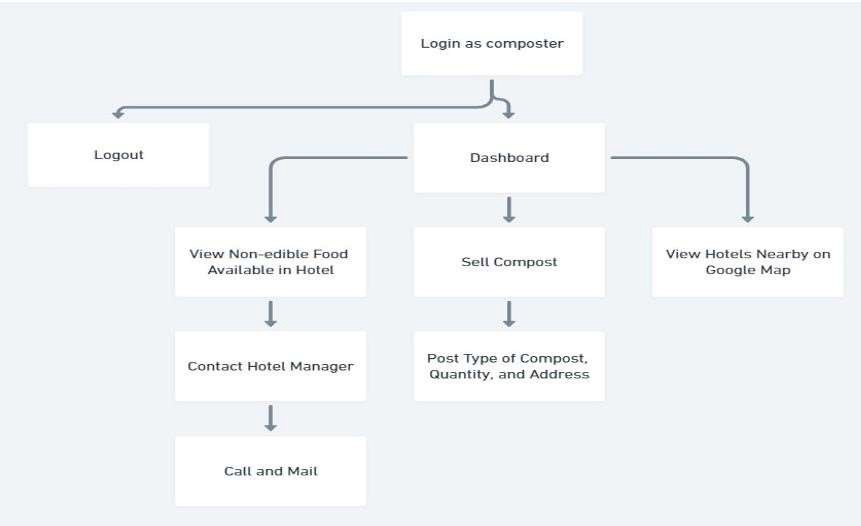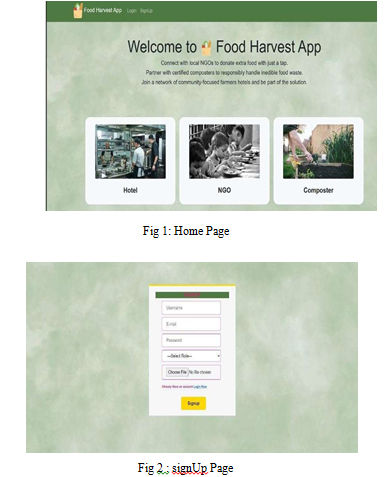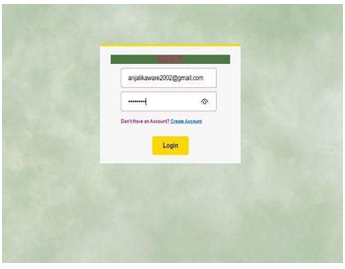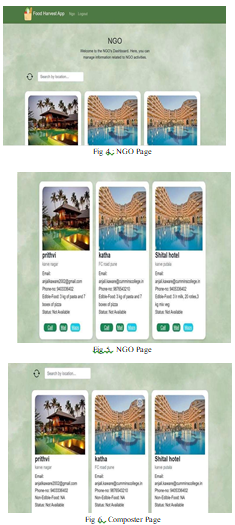Ijraset Journal For Research in Applied Science and Engineering Technology
- Home / Ijraset
- On This Page
- Abstract
- Introduction
- Conclusion
- References
- Copyright
Food Harvest: A Collaborative Solution for Reducing Food Waste
Authors: Ashlesha Katepallewar, Anjali Kaware, Sakshi Suryawanshi, Sanika Thite
DOI Link: https://doi.org/10.22214/ijraset.2024.64049
Certificate: View Certificate
Abstract
Food waste is a significant worldwide issue that impacts both wealthy and developing countries. It is estimated that approximately 50% of food produced is wasted. This wasted food is an inefficient use of time, energy, and resources that went into producing it, in addition to being a loss of nourishment. Food waste also contributes to environmental issues like greenhouse gas emissions and has a large financial impact. To tackle this problem, we suggest an innovative approach. This essay suggests a thorough website designed to address the problems associated with food waste. This solution, which makes use of Firebase Authentication\'s powerful features, attempts to promote a cooperative ecosystem among four important parties: hotel managers, farmers, non- governmental organizations (NGOs), and composters.
Introduction
I. INTRODUCTION
The usage of web apps has increased recently [1, 2]. Web apps are currently used on millions of laptops, desktops, and mobile devices in over 190 countries worldwide. It is well known that web browsers are the most widely used web platforms. The number of web apps is increasing rapidly [3]. Due to that, we developed a web applications front end using visual studio because it provides an open source language and also it is a major developer tool that you can use to complete the entire development cycle in one place and backend using Firebase because it supports centralized data and firebase itself can work for cloud functions . We used vercel to host our web application because it allows them to deploy the frontend easily separately from their backend.
The aim of this initiative is to reduce food waste in India. When food is perfectly fine to be eaten, many restaurants have a tendency to throw it away at the end of the day, wasting enormous amounts of food. While all that food is going to waste, some families are barely able to make healthy meals out of what little money they have. They don't eat three meals a day, so they don't get enough nutrients. We included four Stakeholders. They are hotel managers, NGO, composter and farmers.
- Hotel Managers: Register and log in using Firebase Authentication to report surplus food and schedule pick-up times.
- NGOs: Identify and connect with hotels through the platform, facilitating efficient food redistribution to those in need.
- Composters: Register and receive alerts when food waste is available for collection, promoting the conversion of waste into valuable organic fertilizer.
- Farmers: Access a readily available and affordable source of fertilizer, enhancing agricultural productivity and promoting sustainable farming practices.
- Tech Stack and Functionality:
- Backend: Firebase Authentication serves as the cornerstone, providing secure and scalable user management.
- Real-time Database: Stores and updates information about food availability, pick-up schedules, and composting activities.
- Web Interface: Provides a user-friendly platform for all stakeholders to interact, track progress, and manage food waste effectively.
- Benefits: Reduced Food Waste: Efficient redistribution and composting significantly decrease the amount of food discarded.
- Enhanced Food Security: Facilitates access to nutritious food for vulnerable communities.
- Sustainable Resource Management: Diverts food waste from landfills, promoting organic fertilizer production and reducing environmental impact.
- Economic Opportunities: Creates value for composters and farmers by providing a reliable source of raw materials and organic fertilizer.
- High-Level Impact: This innovative web application offers a robust solution for tackling food waste, fostering collaboration and promoting sustainable practices across the food supply chain. By leveraging the power of technology and fostering stakeholder engagement, this system can contribute to a world with reduced food waste, enhanced food security, and a more sustainable future.
II. MOTIVATION AND BACKGROUND
In today's food waste management practices, local governments typically handle the disposal of food waste by providing designated bins and contracting multiple pickup services for waste collection.
To address the pressing issue of food wastage, we conducted an extensive survey focusing on hotels and their strategies for managing excess food. Our survey explored topics such as the existence of specific policies for handling food waste, challenges encountered, and the daily quantities of wasted food. We also looked into efforts to separate food waste from other types of waste and initiatives aimed at reducing waste through portion control, menu planning, and staff training.
Furthermore, our survey investigated the adoption of composting systems for organic waste within hotels. We collected details on the composting process and how resulting compost is utilized. To further improve waste reduction efforts, we explored the potential implementation of a system or app to facilitate the transfer of waste and surplus food to composters and NGOs.
Based on our findings, we propose the development of an app designed to address food waste by redistributing surplus food to those in need and promoting composting. This app aims to bridge the gap between excess food and hunger, offering a sustainable solution while also contributing to environmental conservation. To encourage collaboration, we assessed hotels' willingness to engage with an app-based platform for food donation, seeking insights into features or functionalities crucial for such cooperation. Ultimately, our goal is to leverage technology to significantly reduce food wastage and support community welfare. Our web application aims to address the challenges faced by hotels in managing their food waste efficiently. It also addresses the prevalent use of composting over traditional fertilizer methods. Additionally, considering the widespread issue of hunger and the difficulty farmers face in obtaining quality compost, our application connects all stakeholders and streamlines the entire process for ease of use and effectiveness.
III. LITERATURE SURVEY
In India, food waste is a serious problem since a lot of it happens at opulent weddings, parties, pubs, restaurants, etc. According to a survey, over 58% of the food that people produce for consumption is thought to be wasted every day. [7]
India is ranked 100th out of 119 nations in the World Hunger Index. In India, there are more hungry people than in a few other countries—more than 65 million people. It is for this reason alone that about 200 million Indians suffer from undernourishment. [7]
The Indian population has a perception that they eat only what they need and do not waste food. That is untrue, though, as a person in India wastes 15–20 kg of food a year. Food waste from India is comparable to that from the UK. Nations with advanced technological capabilities are giving this issue more attention because they think that by reducing food waste, more food can be donated to the poor and needy who cannot even afford a nutritious meal. However, in a developing nation like India, where there is a big population to feed, using or creating such apps can be challenging.
The majority of people ignore the harm that food waste does to our environment, believing that its effects are limited to the physical realm. Methane is a greenhouse gas released into landfills when food waste ends up there. Global warming is the result of this gas's heating of the Earth's atmosphere as it reacts with CO2 and CH4 molecules. It hasn't been addressed by any technologies, or similar steps haven't been done. In India, just one application—that of decreasing food waste and providing aid to the underprivileged—was implemented. Indian application for reducing food waste. An Indian software called No Food Waste lets eateries, food vendors, and events share information about their extra leftover food so that those in need can get it for their own use.
This application gathers and disperses those foodstuffs to the impoverished, nursing homes, orphanages, and homeless individuals. Additionally, users have the option to alert them by indicating their hunger points, in which case food will be distributed. The only condition is that food must be prepared two hours in advance in order for them to accept it. By giving meals to those in need, these applications have altered how artificial intelligence is used. It's regarded as one of the best applications of software engineering.
Food waste is still a bad habit, though. The use of this application has significantly reduced food waste, but more awareness and caution are still needed to build a better world where no food is wasted.
IV. METHODOLOGY
The development and implementation of the proposed solution involve several key methodologies, ensuring a comprehensive and efficient approach to tackling food waste and enhancing communication among stakeholders.
- Components Of Methodology: Stakeholder Engagement and Project Planning: Finding the key players, such as hotels, purchasers, NGOs, composters, and farmers, is the first step in this process. Next, a thorough project plan is drafted, outlining each stakeholder's responsibilities, roles, and due dates. By making sure that everyone is informed of their roles and the project's schedule, this step promotes efficient cooperation and accountability.
- Website Development: The next phase focuses on creating and constructing an intuitive website with distinct user interfaces tailored for hotel operators, non-profit organizations, composters, and farmers/buyers. Secure login procedures are established for each type of user to guarantee data privacy and protect sensitive information. This ensures that the website is user-friendly and secure, facilitating smooth interactions among all stakeholders.
- Hotel Manager Interaction Module: A specialized module is developed for hotel managers, allowing them to register, input information about surplus food, update inventory, and manage surplus food data efficiently. Additionally, this module provides hotel managers with with the capability to search for local NGOs, composters, and farmers/buyers, enabling them to connect easily with other stakeholders involved in the food redistribution and waste management process.
- NGO Interaction Module: A module is created for NGOs, enabling them to plan pickups, view details about surplus food, and communicate with hotels via email and phone calls. This module also includes a search function, allowing NGOs to locate hotels in their vicinity. This functionality ensures that NGOs can efficiently organize food collection and distribution, enhancing their operational effectiveness.
- Composter Interaction with Hotel Module: This module allows composters to sell compost, purchase compostable waste from hotels, and adhere to waste collection schedules. It includes a search feature for composters to find hotels in the area, ensuring they can easily locate sources of compostable waste. This module facilitates the efficient conversion of food waste into valuable compost, promoting sustainable waste management practices.
- Compost Purchase for Farmer Module: A dedicated section is provided for buyers and farmers to browse available compost. This module also offers communication channels, enabling farmers to contact composters directly. functionality ensures that farmers have easy access to organic fertilizers, supporting sustainable agriculture
- Farmer Interface Module: An interface is developed for farmers, allowing them to view available compost, contact compost makers via phone calls or emails, and see their locations on a map. A search feature is also implemented, helping farmers find nearby composters. This module ensures that farmers can efficiently obtain compost, enhancing their farming operations and contributing to a sustainable agricultural ecosystem. practices and improving soil health.
V. BLOCK DIAGRAM
A. Login

Fig 1 . Login Page Dataflow Diagram This
B. SignUp

Fig 2 : SignUp Page Dataflow Diagram
C. Hotel Manager :

Fig 3 : Hotel Manager Page Dataflow Diagram
D. Composter

Fig 4 : Composter Page Dataflow Diagram
E. NGO

Fig 5 : NGO Page Dataflow Diagram
F. Farmer

Fig 6 : Farmer Page Dataflow Diagram
VI. PROPOSED SOLUTION


Fig 3 : Login page


Fig 7 . Farmer Page
Conclusion
Food wastage is a major problem. This paper focuses attention on keeping in view the vast population that needs food to curb hunger and what steps can be taken with the usage of new technologies. Food waste is a result of throwing away good eatable food before it even reaches the mouths of humans. Food storage is causing the untimely death of approximately 3.1 million children under the age of five across the world. Wastage of food is a real issue faced by society concurrently with other environmentrelated issues. Hunger will only be controlled by avoiding food waste in any way and at the time of marriage since they make a good amount of food instead of throwing it away more food, the plan should be confirmed to manage unhealthy foods. Food waste in fast food restaurants is a serious issue that contributes to social, environmental, and economic problems. It leads to higher rates of food insecurity, especially among needy families, causes atmospheric pollution, and results in millions of dollars wasted on inputs. To combat this issue, we proposed a plan to encourage fast-food chains to donate excess food, utilize biodegradable supplies. Better food waste reduction is the goal of the web application. By employing this technology to make food sharing and distribution easier within the Indian community, our suggested solution will decrease food waste. The first step in creating a more effective system to lower daily food waste is this work.
References
[1] Accessed 01-01-2020 [online]. Harshita Tyagi, 2020. “World Food Day 2020: How food waste affects the economy” Times Now News, “Food wastage in India” [2] Accessed 01-09-2019 [online] “Food Wastage in India” Chintan India “The food not eaten” pp. 1-4. [3] Accessed 01-01-2020 [online]. Harshita Tyagi, 2020. “World Food Day 2020: How food waste affects the economy” Times Now News, “Food wastage stats” [4] Accessed 22-07-19 [online]. Available FSSAI.gov.in upload media FSSAI _news _Food _Express _22_07_2019 [5] United Nations, The 17 Sustainable Development Goals (SDGs) [online] Available at: https://sdgs.un.org/goals [Accessed at: 20 Feb. 2022] [6] United Nations, 2nd Sustainable Development Goals (SDGs): NO HUNGER [online] Available at: https://sdgs.un.org/goals/goal2 [Accessed at: 20 Feb. 2022] [7] Ayesha Anzer, Hadeel A. Tabaza, and Wedad Ahmed“A Food Wastage Reduction Mobile Application” College of Engineering (CoE) Abu Dhabi University Abu Dhabi, United Arab Emirates {1063572, 1007353, } [8] Roopika Nigam, Sanjana Sharma, Food Waste Management, Amity Journal of Energy and environmental studies 2017, Volume 3 Number 2
Copyright
Copyright © 2024 Ashlesha Katepallewar, Anjali Kaware, Sakshi Suryawanshi, Sanika Thite. This is an open access article distributed under the Creative Commons Attribution License, which permits unrestricted use, distribution, and reproduction in any medium, provided the original work is properly cited.

Download Paper
Paper Id : IJRASET64049
Publish Date : 2024-08-22
ISSN : 2321-9653
Publisher Name : IJRASET
DOI Link : Click Here
 Submit Paper Online
Submit Paper Online

